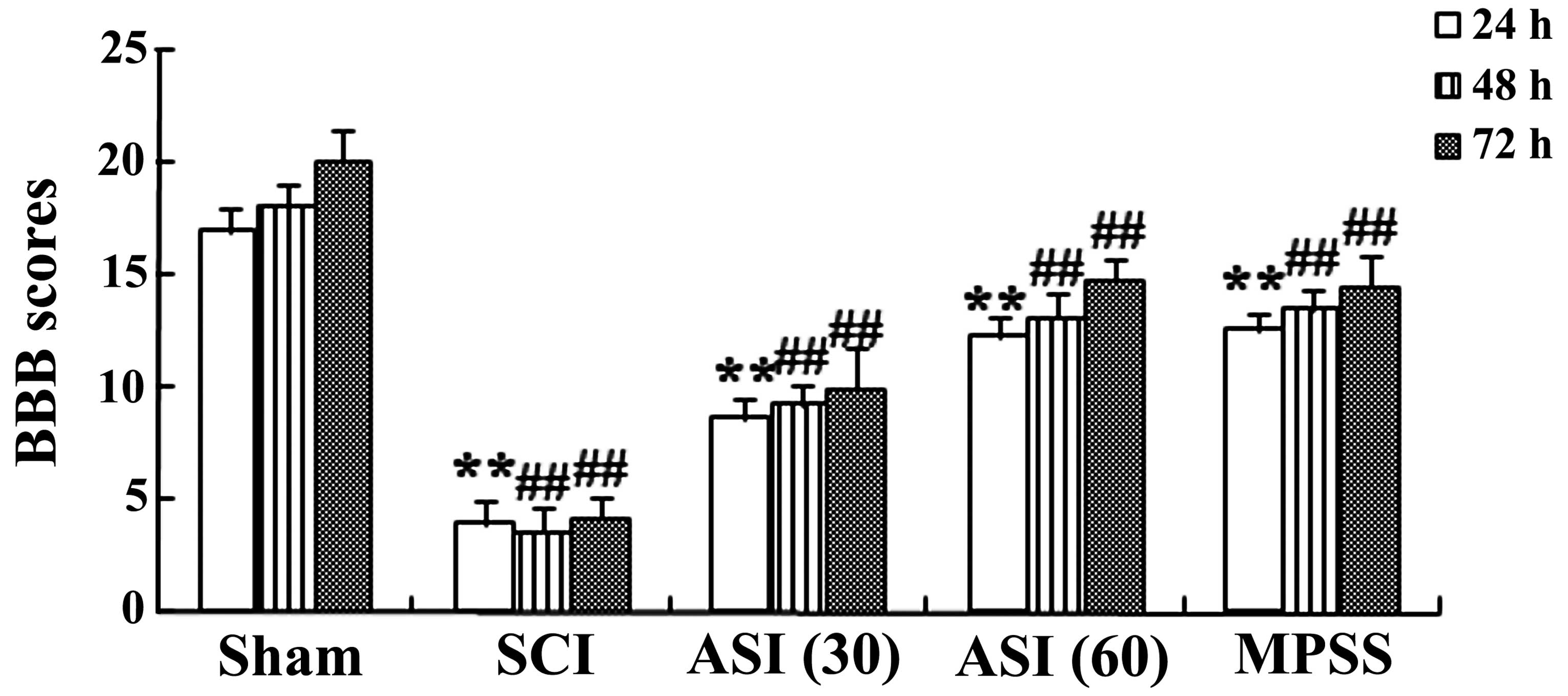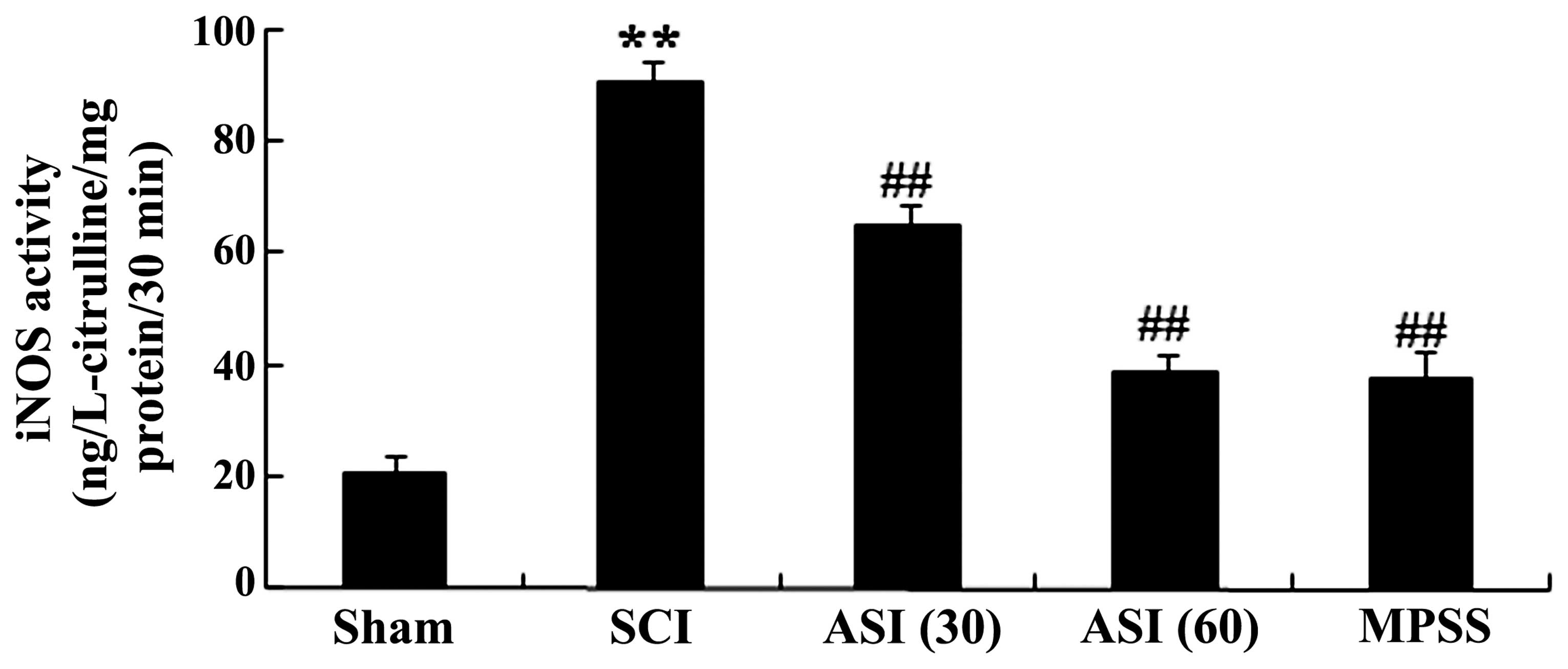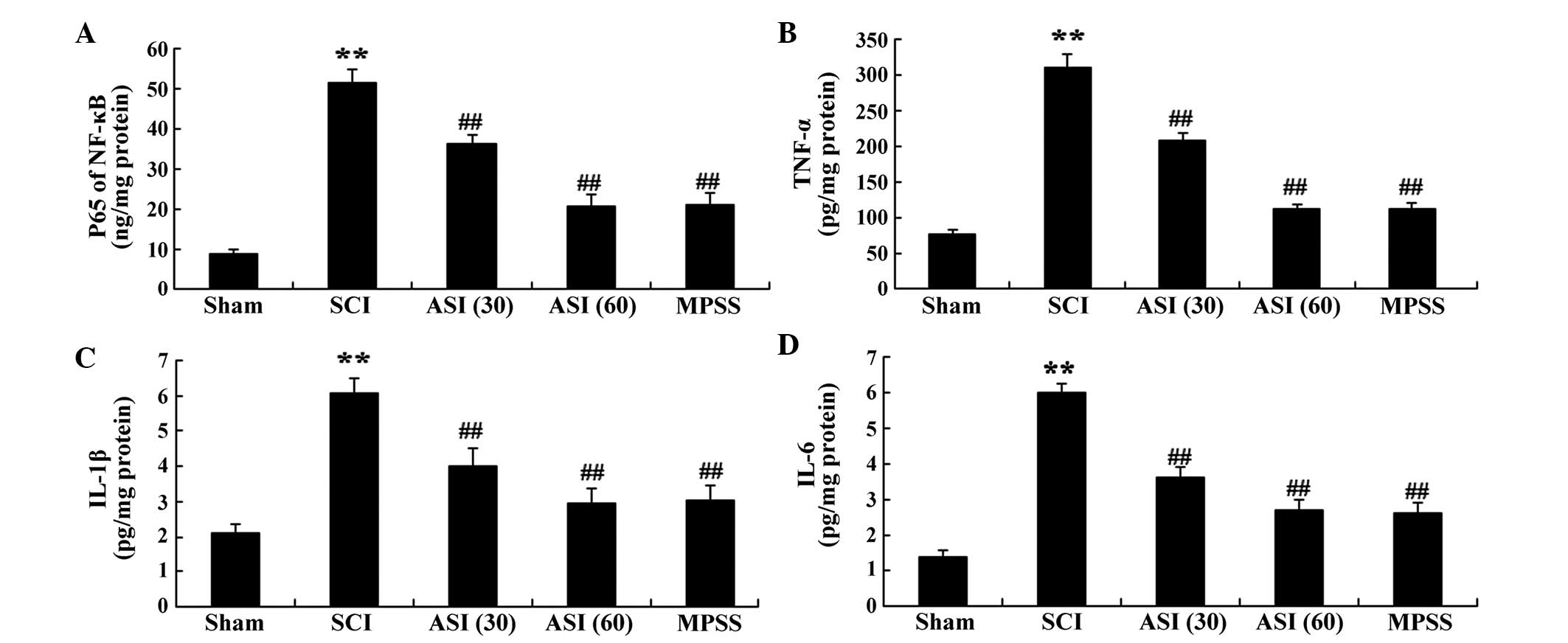|
1
|
Liu C, Wu W, Zhang B, Xiang J and Zou J:
Temporospatial expression and cellular localization of glutamine
synthetase following traumatic spinal cord injury in adult rats.
Mol Med Rep. 7:1431–1436. 2013.PubMed/NCBI
|
|
2
|
Ravikumar R, Fugaccia I, Scheff SW, Geddes
JW, Srinivasan C and Toborek M: Nicotine attenuates morphological
deficits in a contusion model of spinal cord injury. J Neurotrauma.
22:240–251. 2005. View Article : Google Scholar : PubMed/NCBI
|
|
3
|
Furlan JC, Sakakibara BM, Miller WC and
Krassioukov AV: Global incidence and prevalence of traumatic spinal
cord injury. Can J Neurol Sci. 40:456–464. 2013. View Article : Google Scholar : PubMed/NCBI
|
|
4
|
Hong Z, Hong H, Chen H, Wang Z and Hong D:
Investigation of the protective effect of erythropoietin on spinal
cord injury in rats. Exp Ther Med. 2:837–841. 2011.
|
|
5
|
Oyinbo CA: Secondary injury mechanisms in
traumatic spinal cord injury: A nugget of this multiply cascade.
Acta Neurobiol Exp (Wars). 71:281–299. 2011.
|
|
6
|
Smith JA, Park S, Krause JS and Banik NL:
Oxidative stress, DNA damage and the telomeric complex as
therapeutic targets in acute neurodegeneration. Neurochem Int.
62:764–775. 2013. View Article : Google Scholar : PubMed/NCBI
|
|
7
|
Cavus G, Altas M, Aras M, Ozgür T,
Serarslan Y, Yilmaz N, Sefil F and Ulutas KT: Effects of
montelukast and methylprednisolone on experimental spinal cord
injury in rats. Eur Rev Med Pharmacol Sci. 18:1770–1777.
2014.PubMed/NCBI
|
|
8
|
Tavukçu HH, Sener TE, Tinay I, Akbal C,
Erşahin M, Cevik O, Cadirci S, Reiter RJ and Sener G: Melatonin and
tadalafil treatment improves erectile dysfunction after spinal cord
injury in rats. Clin Exp Pharmacol Physiol. 41:309–316. 2014.
View Article : Google Scholar : PubMed/NCBI
|
|
9
|
Zhang W, Cheng L, Hou Y, Si M, Zhao YP and
Nie L: Plumbagin protects against spinal cord injury-induced
oxidative stress and inflammation in wistar rats through Nrf-2
upregulation. Drug Res (Stuttg). 2014.
|
|
10
|
Nacar OA, Eroglu H, Cetinalp NE, Menekse
G, Yildirim AE, Uckun OM, Daglioglu E, Turkoglu OF and Belen AD:
Systemic administration of atorvastatin improves locomotor
functions and hyperacute-acute response after experimental spinal
cord injury: An ultrastructural and biochemical analysis. Turk
Neurosurg. 24:337–343. 2014.PubMed/NCBI
|
|
11
|
Kanno A, Ozawa T and Umezawa Y:
Bioluminescent imaging of MAPK function with intein-mediated
reporter gene assay. Methods Mol Biol. 574:185–192. 2009.
View Article : Google Scholar : PubMed/NCBI
|
|
12
|
Galan-Arriero I, Avila-Martin G,
Ferrer-Donato A, Gomez-Soriano J, Bravo-Esteban E and Taylor J:
Oral administration of the p38α MAPK inhibitor, UR13870, inhibits
affective pain behavior after spinal cord injury. Pain.
155:2188–2198. 2014. View Article : Google Scholar : PubMed/NCBI
|
|
13
|
Qu WS, Tian DS, Guo ZB, Fang J, Zhang Q,
Yu ZY, Xie MJ, Zhang HQ, Lü JG and Wang W: Inhibition of EGFR/MAPK
signaling reduces microglial inflammatory response and the
associated secondary damage in rats after spinal cord injury. J
Neuroinflammation. 9:1782012. View Article : Google Scholar : PubMed/NCBI
|
|
14
|
Lin X, Huang R, Zhang S, Wei L, Zhuo L, Wu
X, Tang A and Huang Q: Beneficial effects of asiaticoside on
cognitive deficits in senescence-accelerated mice. Fitoterapia.
87:69–77. 2013. View Article : Google Scholar : PubMed/NCBI
|
|
15
|
Chen S, Yin ZJ, Jiang C, Ma ZQ, Fu Q, Qu R
and Ma SP: Asiaticoside attenuates memory impairment induced by
transient cerebral ischemia-reperfusion in mice through
anti-inflammatory mechanism. Pharmacol Biochem Behav. 122:7–15.
2014. View Article : Google Scholar : PubMed/NCBI
|
|
16
|
Hsu JY, McKeon R, Goussev S, Werb Z, Lee
JU, Trivedi A and Noble-Haeusslein LJ: Matrix metalloproteinase-2
facilitates wound healing events that promote functional recovery
after spinal cord injury. J Neurosci. 26:9841–9850. 2006.
View Article : Google Scholar : PubMed/NCBI
|
|
17
|
Basso DM, Beattie MS, Bresnahan JC,
Anderson DK, Faden AI, Gruner JA, Holford TR, Hsu CY, Noble LJ,
Nockels R, et al: MASCIS evaluation of open field locomotor scores:
Effects of experience and teamwork on reliability. ++multicenter
animal spinal cord injury study. J Neurotrauma. 13:343–359. 1996.
View Article : Google Scholar : PubMed/NCBI
|
|
18
|
Wang Z, Zhang C, Hong Z, Chen H, Chen W
and Chen G: C/EBP homologous protein (CHOP) mediates neuronal
apoptosis in rats with spinal cord injury. Exp Ther Med. 5:107–111.
2013.
|
|
19
|
Liu G, Wang X, Shao G and Liu Q:
Genetically modified Schwann cells producing glial cell
line-derived neurotrophic factor inhibit neuronal apoptosis in rat
spinal cord injury. Mol Med Rep. 9:1305–1312. 2014.PubMed/NCBI
|
|
20
|
Xie YG, Mu HJ, Li Z, Ma JH and Wang YL:
Supression of chronic central pain by superoxide dismutase in rats
with spinal cord injury: Inhibition of the NMDA receptor
implicated. Exp Ther Med. 8:1137–1141. 2014.PubMed/NCBI
|
|
21
|
Kurtoglu T, Basoglu H, Ozkisacik EA, Cetin
NK, Tataroglu C, Yenisey C and Discigil B: Effects of cilostazol on
oxidative stress, systemic cytokine release, and spinal cord injury
in a rat model of transient aortic occlusion. Ann Vasc Surg.
28:479–488. 2014. View Article : Google Scholar : PubMed/NCBI
|
|
22
|
Li YD, Ma YH, Zhao JX and Zhao XK:
Protection of ultra-filtration extract from Danggui Buxue Decoction
on oxidative damage in cardiomyocytes of neonatal rats and its
mechanism. Chin J Integr Med. 17:854–859. 2011. View Article : Google Scholar : PubMed/NCBI
|
|
23
|
Song Y, Liu J, Zhang F, Zhang J, Shi T and
Zeng Z: Antioxidant effect of quercetin against acute spinal cord
injury in rats and its correlation with the p38MAPK/iNOS signaling
pathway. Life Sci. 92:1215–1221. 2013. View Article : Google Scholar : PubMed/NCBI
|
|
24
|
Shukla A, Rasik AM and Dhawan BN:
Asiaticoside-induced elevation of antioxidant levels in healing
wounds. Phytother Res. 13:50–54. 1999. View Article : Google Scholar : PubMed/NCBI
|
|
25
|
Wan J, Gong X, Jiang R, Zhang Z and Zhang
L: Antipyretic and anti-inflammatory effects of asiaticoside in
lipopolysac-charide-treated rat through up-regulation of heme
oxygenase-1. Phytother Res. 27:1136–1142. 2013. View Article : Google Scholar
|
|
26
|
Xu CL, Wang QZ, Sun LM, Li XM, Deng JM, Li
LF, Zhang J, Xu R and Ma SP: Asiaticoside: Attenuation of
neurotoxicity induced by MPTP in a rat model of Parkinsonism via
maintaining redox balance and up-regulating the ratio of Bcl-2/Bax.
Pharmacol Biochem Behav. 100:413–418. 2012. View Article : Google Scholar
|
|
27
|
Guo JS, Cheng CL and Koo MW: Inhibitory
effects of Centella asiatica water extract and asiaticoside on
inducible nitric oxide synthase during gastric ulcer healing in
rats. Planta Med. 70:1150–1154. 2004. View Article : Google Scholar
|
|
28
|
Manhas A, Khanna V, Prakash P, Goyal D,
Malasoni R, Naqvi A, Dwivedi AK, Dikshit M and Jagavelu K: Curcuma
oil reduces endothelial cell-mediated inflammation in
postmyocardial ischemia/reperfusion in rats. J Cardiovasc
Pharmacol. 64:228–236. 2014. View Article : Google Scholar : PubMed/NCBI
|
|
29
|
Nguyen DH, Cho N, Satkunendrarajah K,
Austin JW, Wang J and Fehlings MG: Immunoglobulin G (IgG)
attenuates neuroinflam-mation and improves neurobehavioral recovery
after cervical spinal cord injury. J Neuroinflammation. 9:2242012.
View Article : Google Scholar
|
|
30
|
Casella GT, Bunge MB and Wood PM: Improved
immunocyto-chemical identification of neural, endothelial, and
inflammatory cell types in paraffin-embedded injured adult rat
spinal cord. J Neurosci Methods. 139:1–11. 2004. View Article : Google Scholar : PubMed/NCBI
|
|
31
|
Zhang LN, Zheng JJ, Zhang L, Gong X, Huang
H, Wang CD, Wang B, Wu MJ, Li XH, Sun WJ, et al: Protective effects
of asiaticoside on septic lung injury in mice. Exp Toxicol Pathol.
63:519–525. 2011. View Article : Google Scholar
|
|
32
|
Bhaumik SK, Paul J, Naskar K, Karmakar S
and De T: Asiaticoside induces tumour-necrosis-factor-α-mediated
nitric oxide production to cure experimental visceral leishmaniasis
caused by antimony-susceptible and -resistant Leishmania donovani
strains. J Antimicrob Chemother. 67:910–920. 2012. View Article : Google Scholar : PubMed/NCBI
|
|
33
|
Zhou C, Shi X, Huang H, Zhu Y and Wu Y:
Montelukast attenuates neuropathic pain through inhibiting p38
mitogen-activated protein kinase and nuclear factor-kappa B in a
rat model of chronic constriction injury. Anesth Analg.
118:1090–1096. 2014. View Article : Google Scholar : PubMed/NCBI
|
|
34
|
Ghasemlou N, Lopez-Vales R, Lachance C,
Thuraisingam T, Gaestel M, Radzioch D and David S:
Mitogen-activated protein kinase-activated protein kinase 2 (MK2)
contributes to secondary damage after spinal cord injury. J
Neurosci. 30:13750–13759. 2010. View Article : Google Scholar : PubMed/NCBI
|
|
35
|
Li XQ, Cao XZ, Wang J, Fang B, Tan WF and
Ma H: Sevoflurane preconditioning ameliorates neuronal deficits by
inhibiting microglial MMP-9 expression after spinal cord
ischemia/reper-fusion in rats. Mol Brain. 7:692014. View Article : Google Scholar
|
|
36
|
Zhang L, Li HZ, Gong X, Luo FL, Wang B, Hu
N, Wang CD, Zhang Z and Wan JY: Protective effects of Asiaticoside
on acute liver injury induced by lipopolysaccharide/D-galactosamine
in mice. Phytomedicine. 17:811–819. 2010. View Article : Google Scholar : PubMed/NCBI
|

















